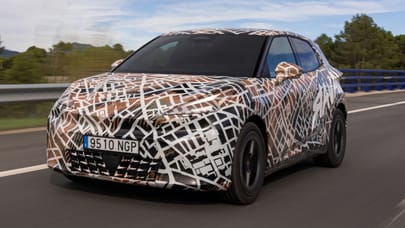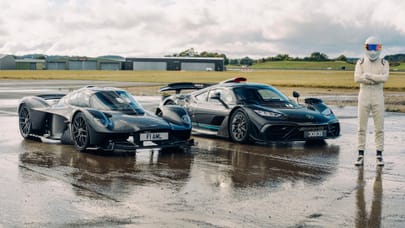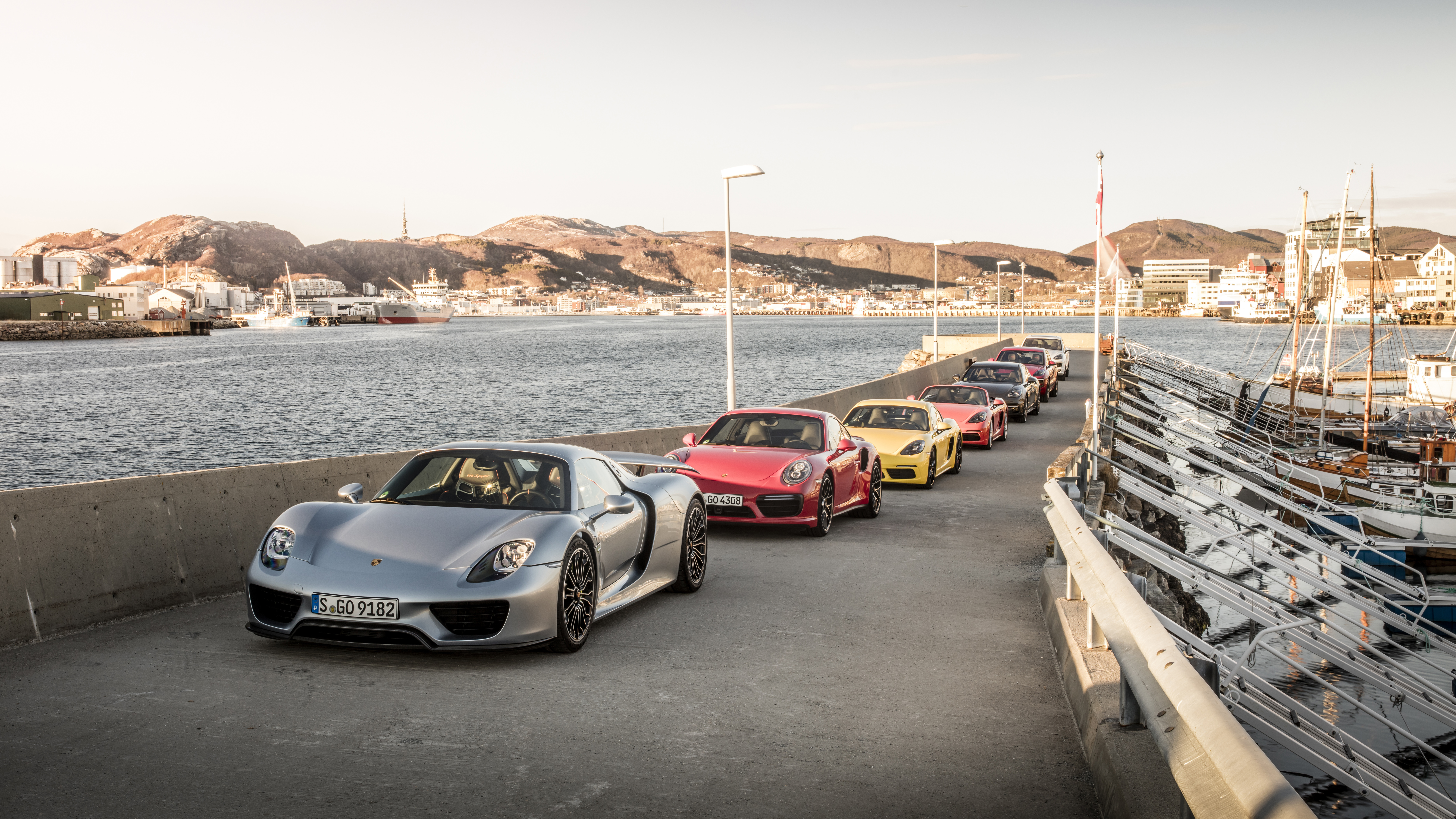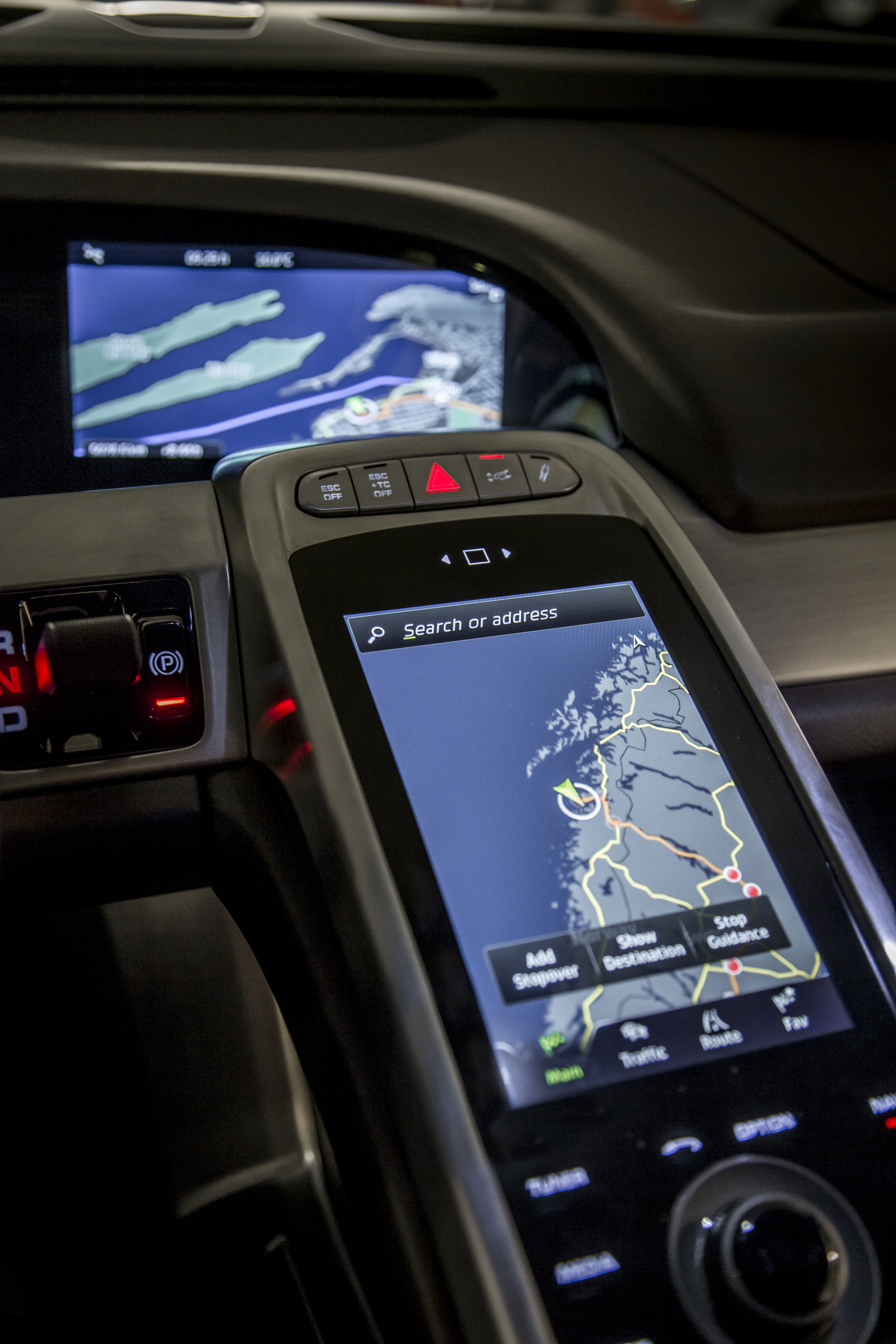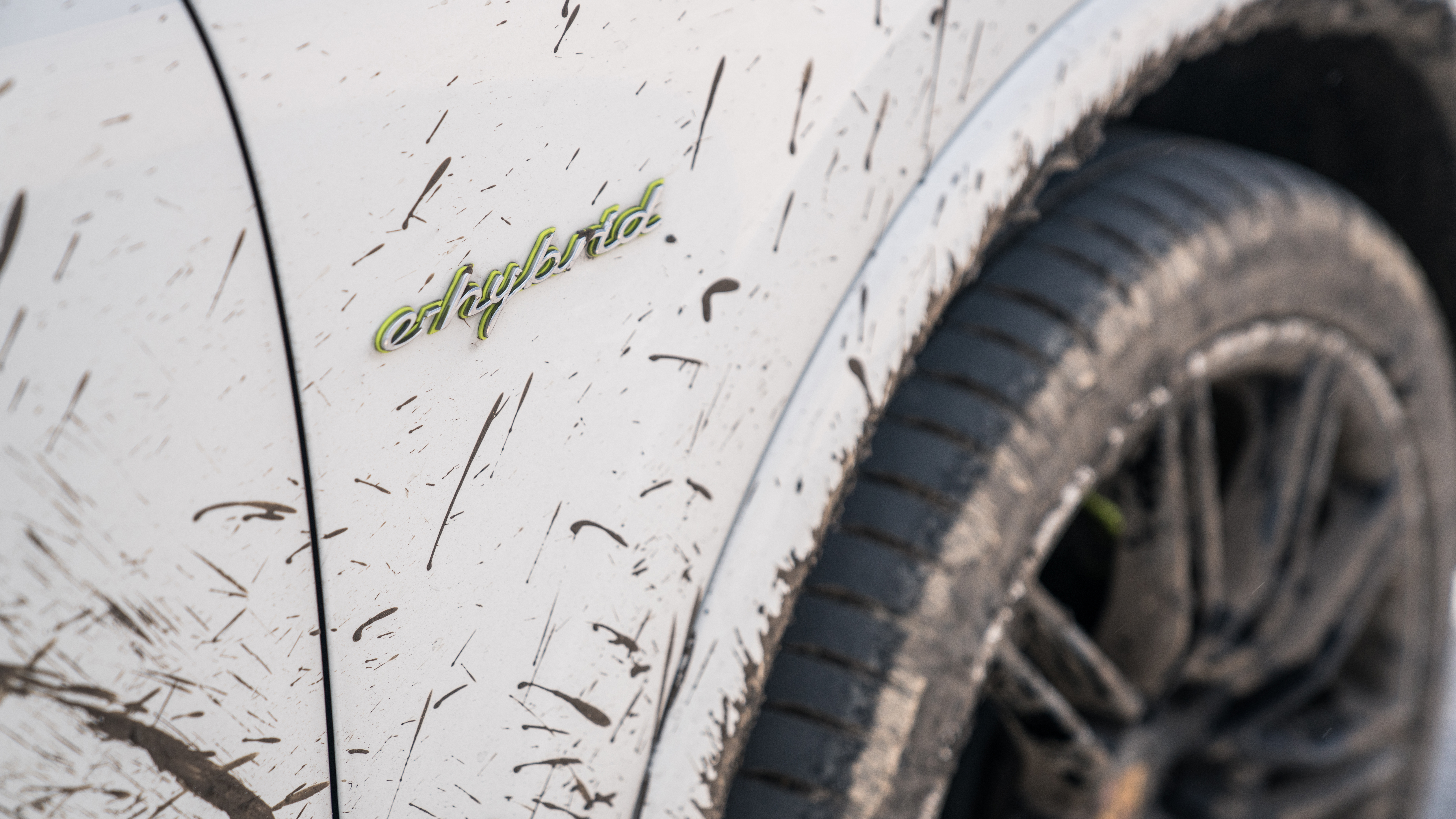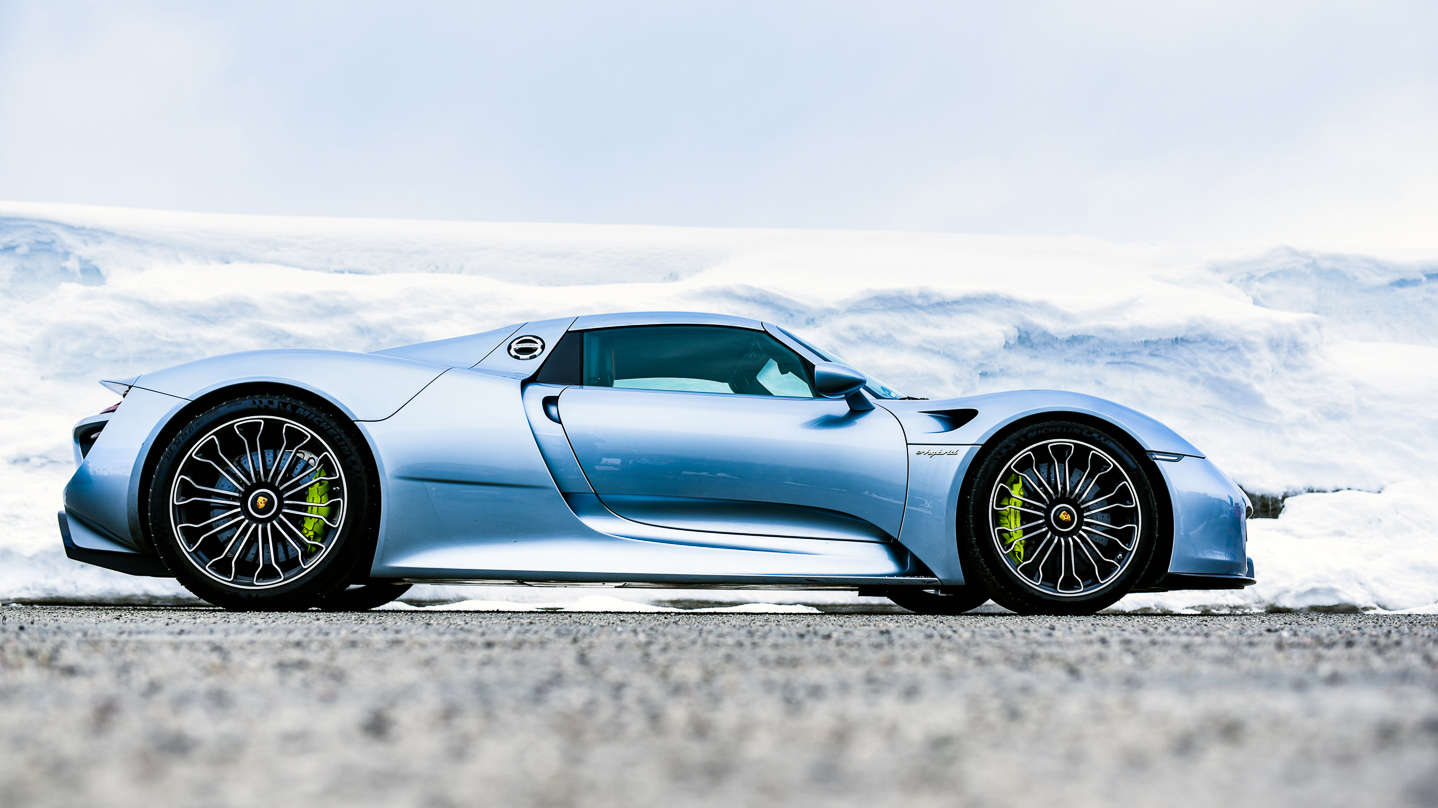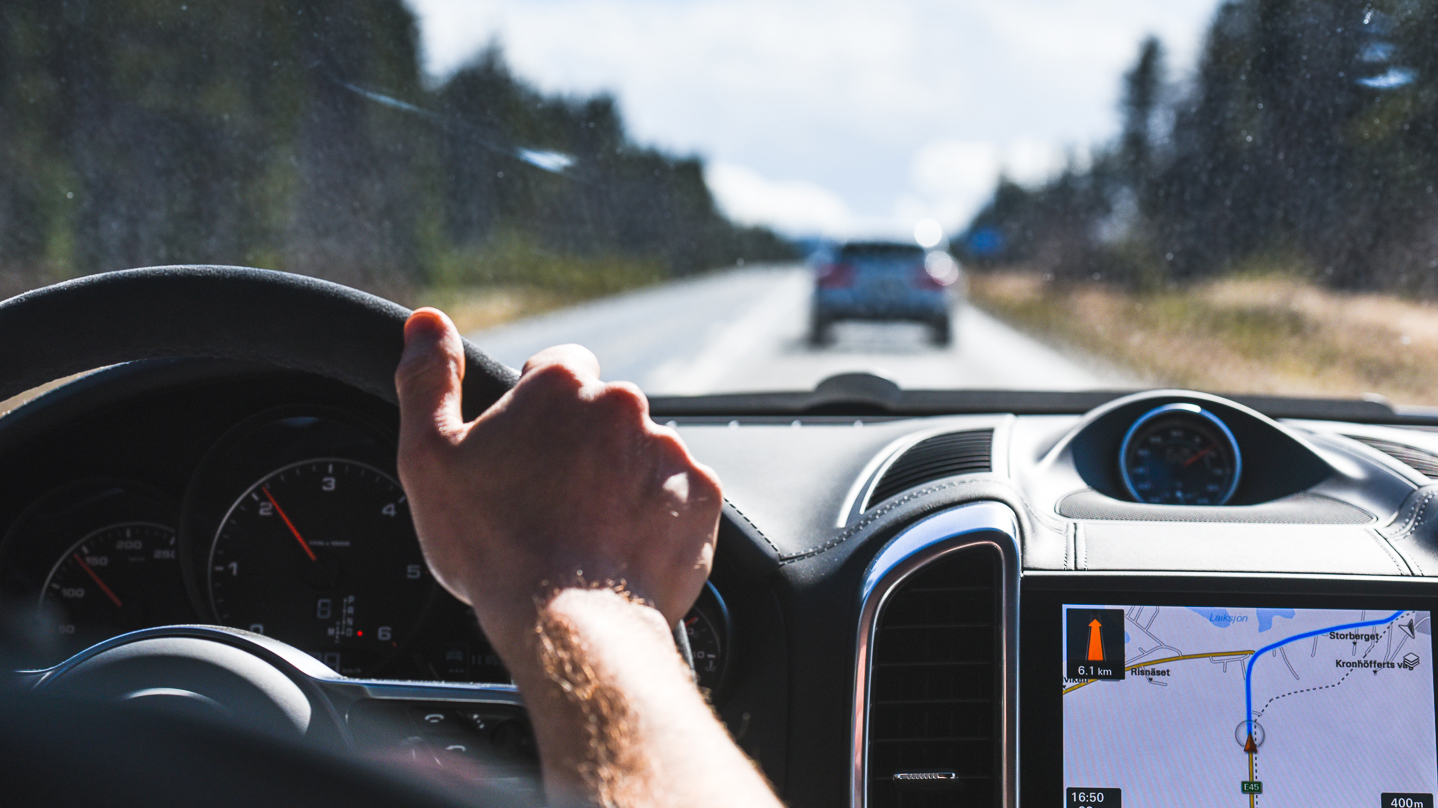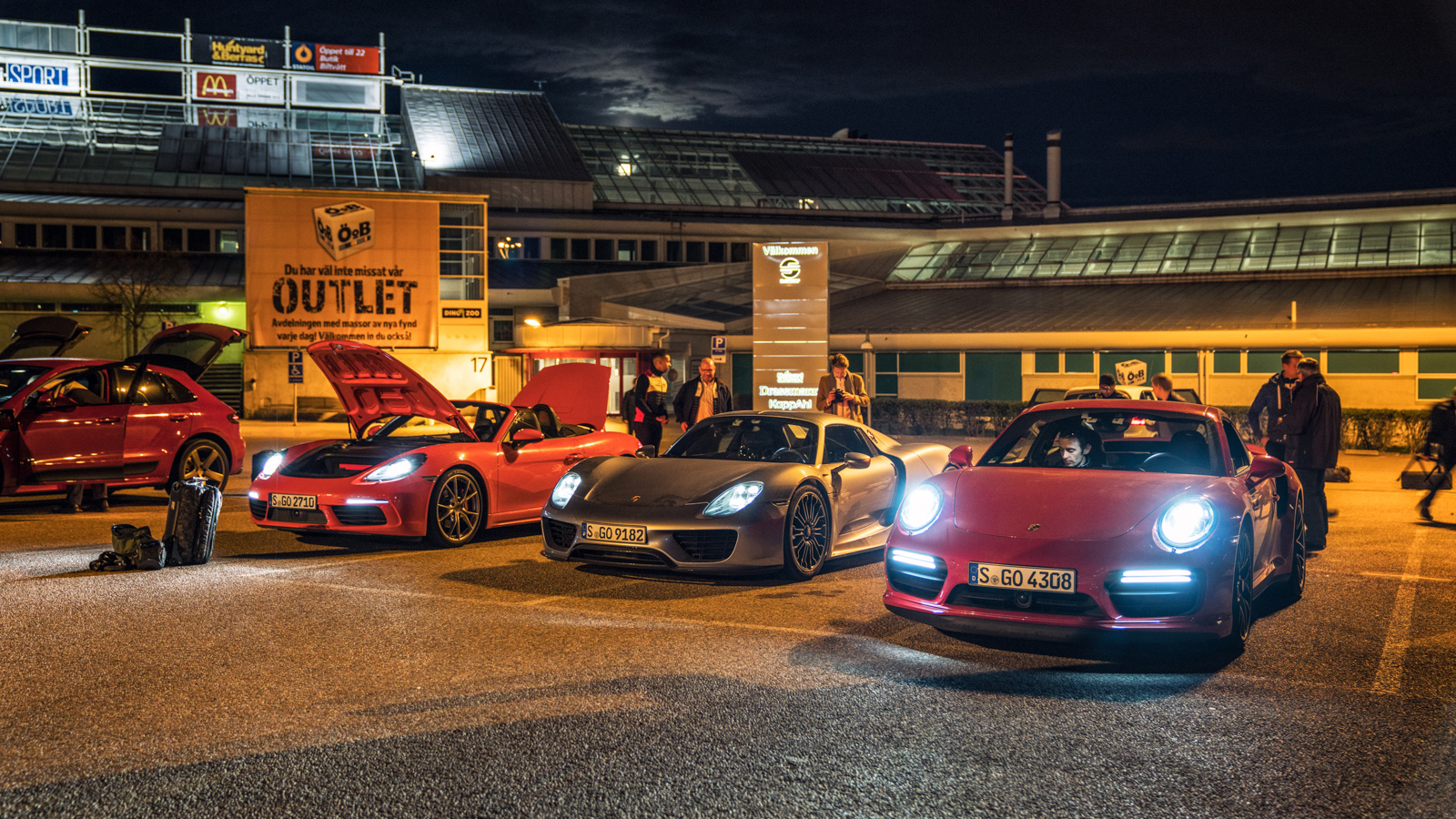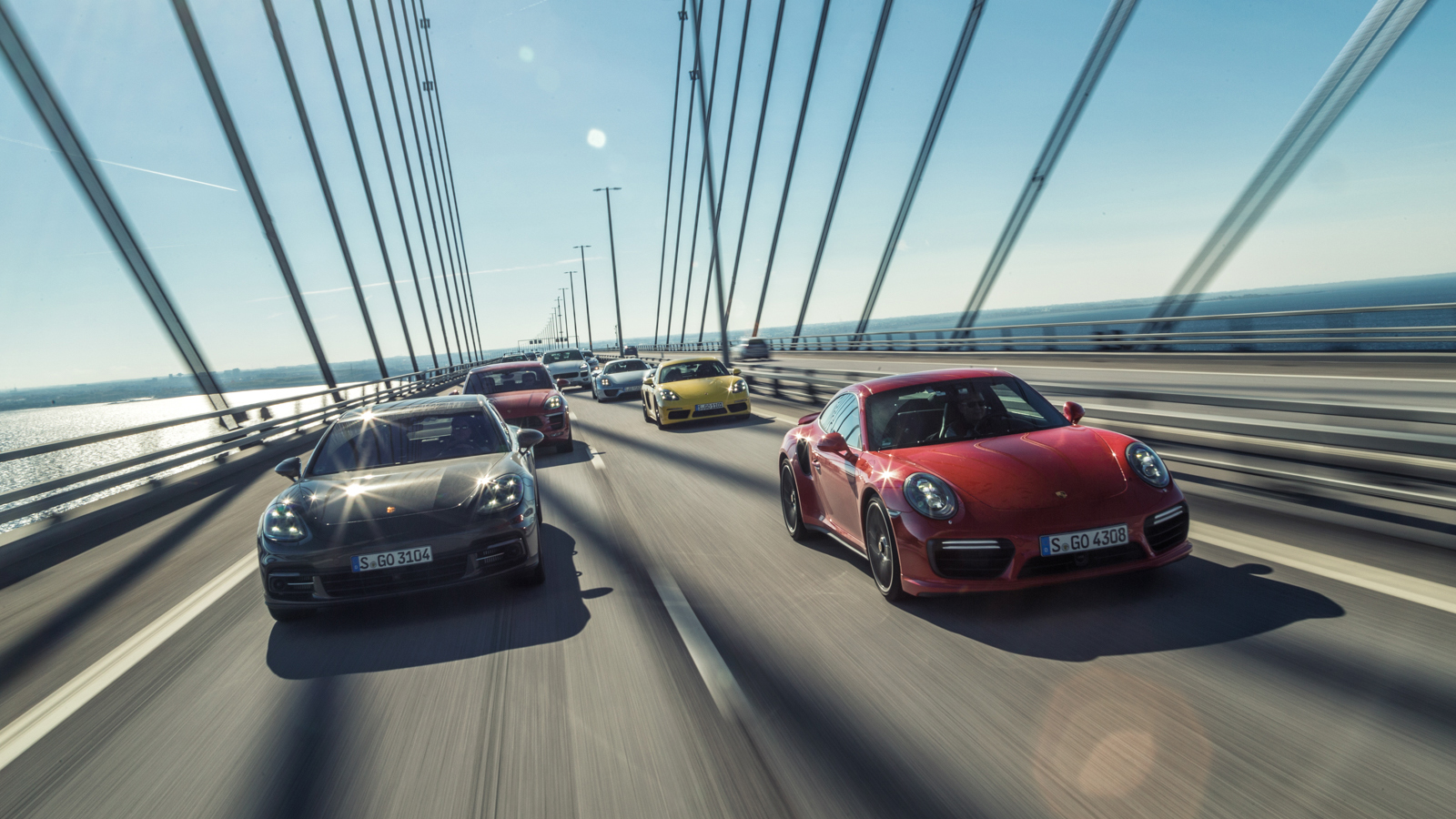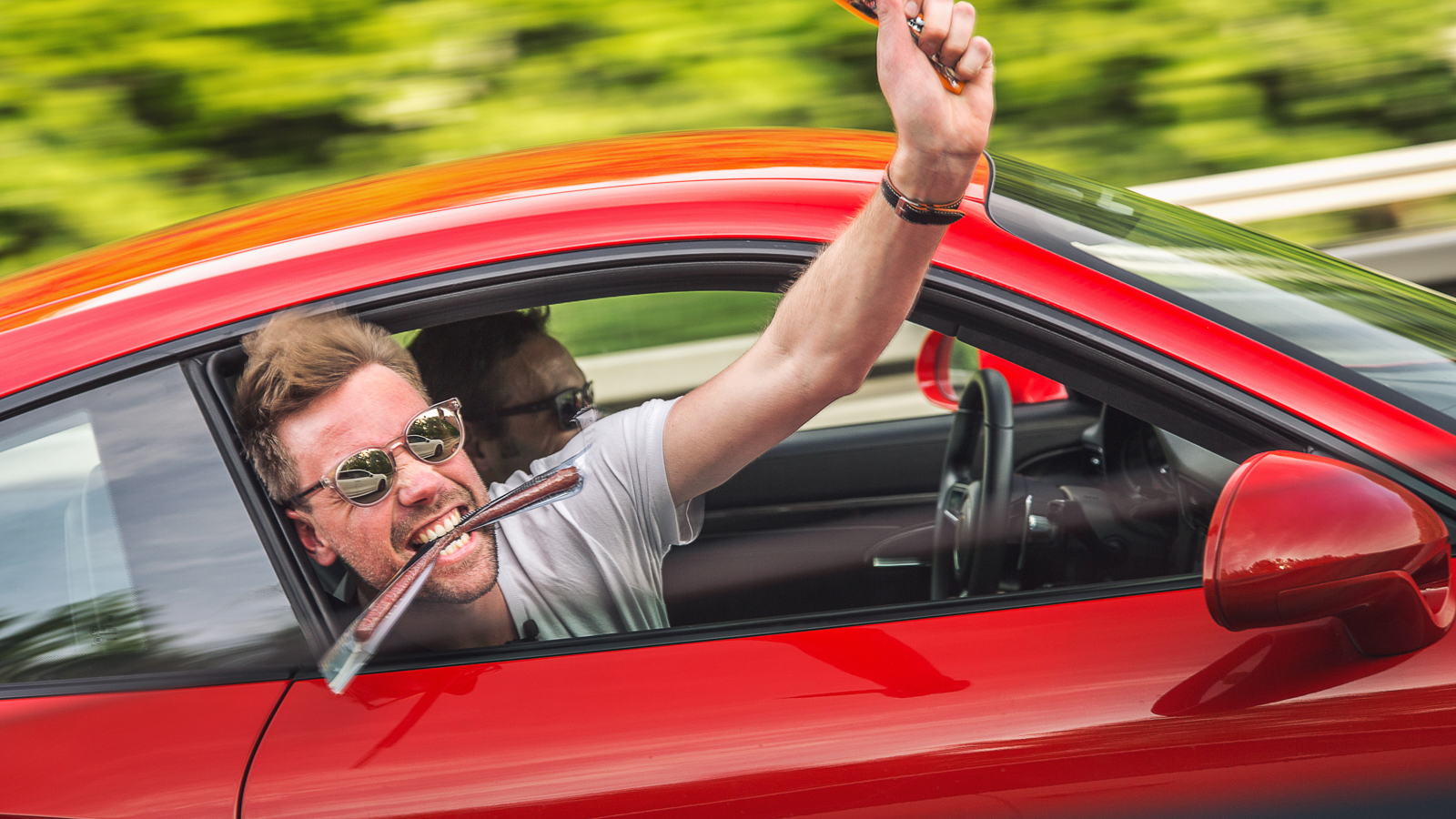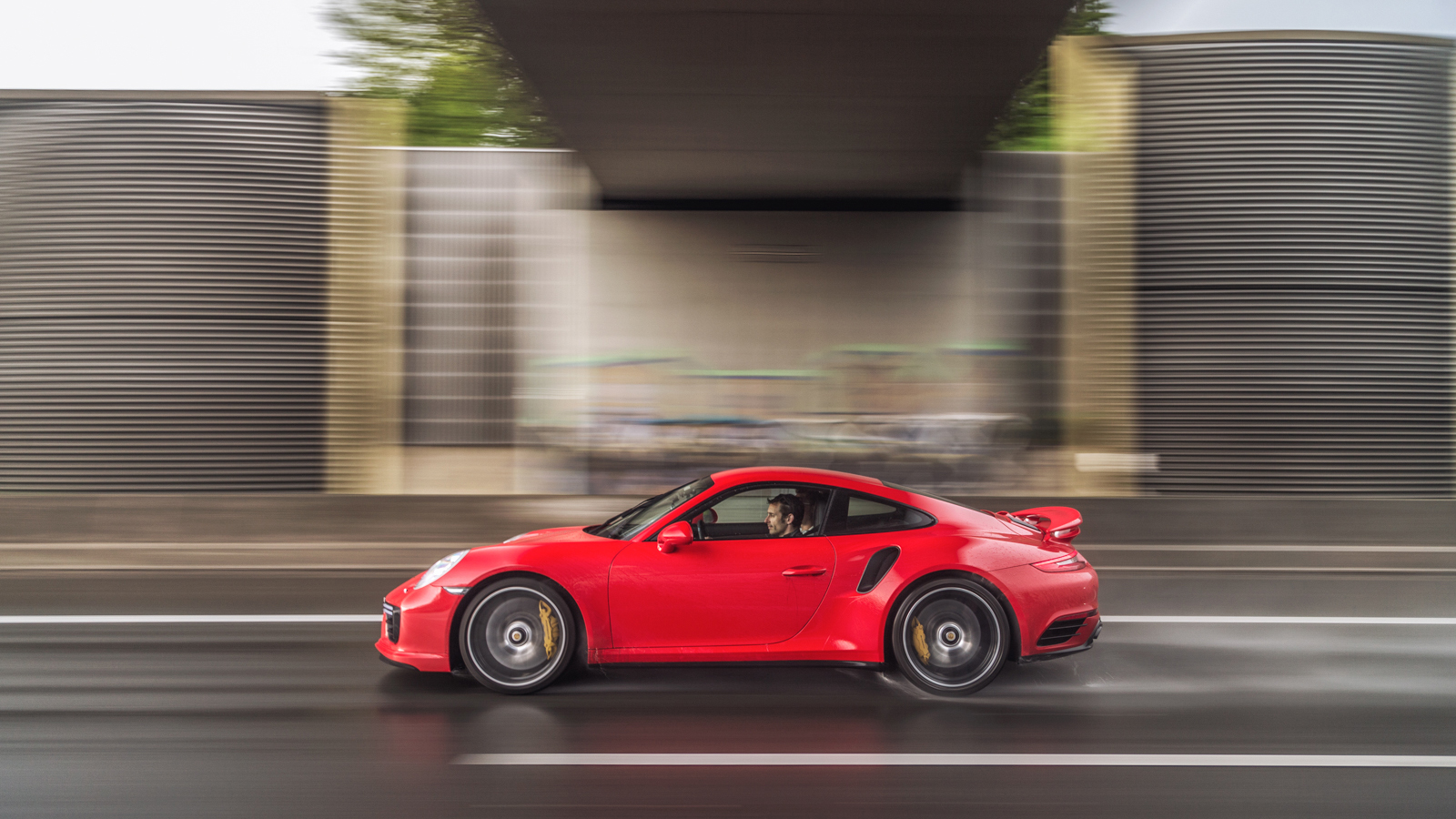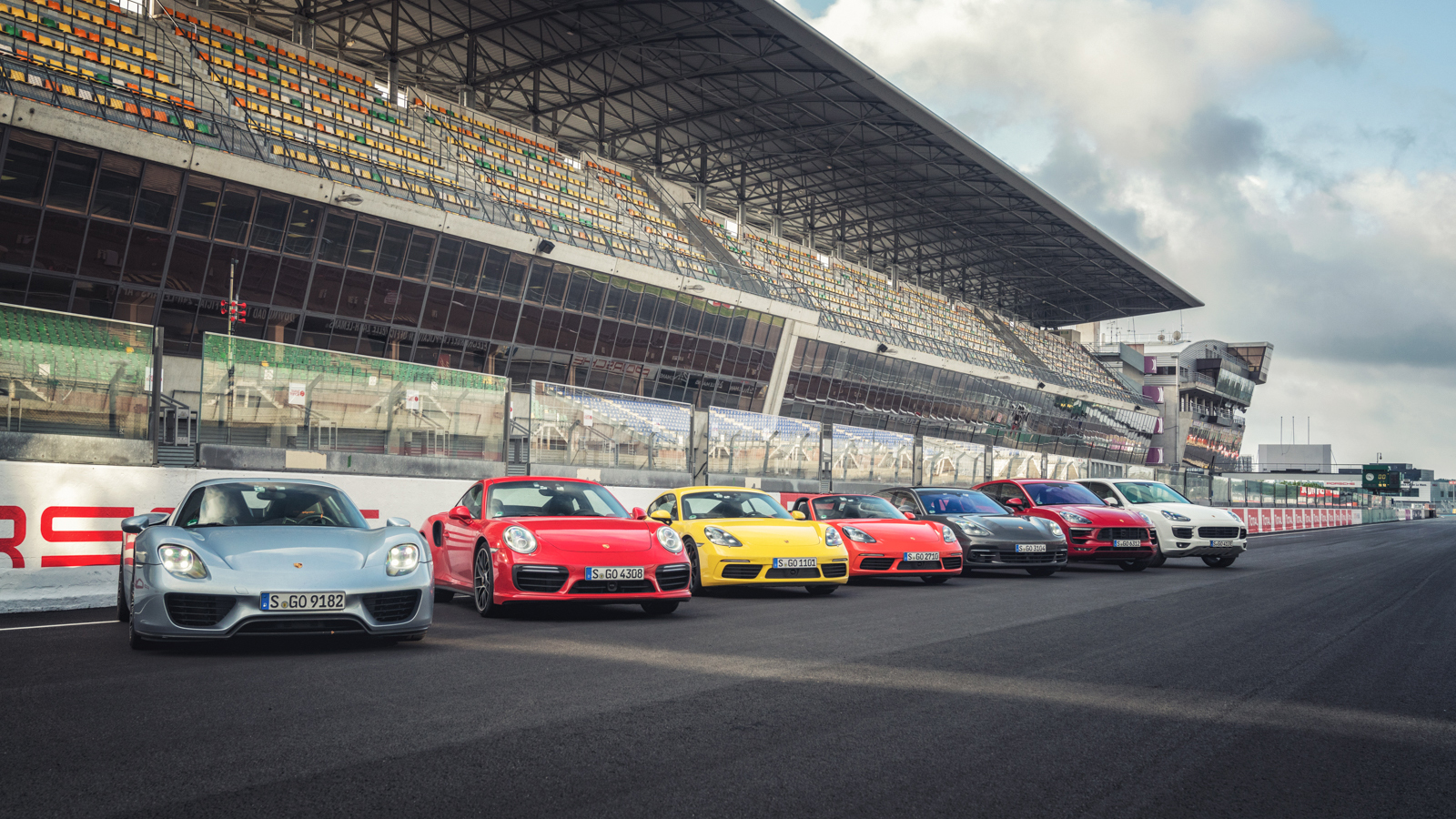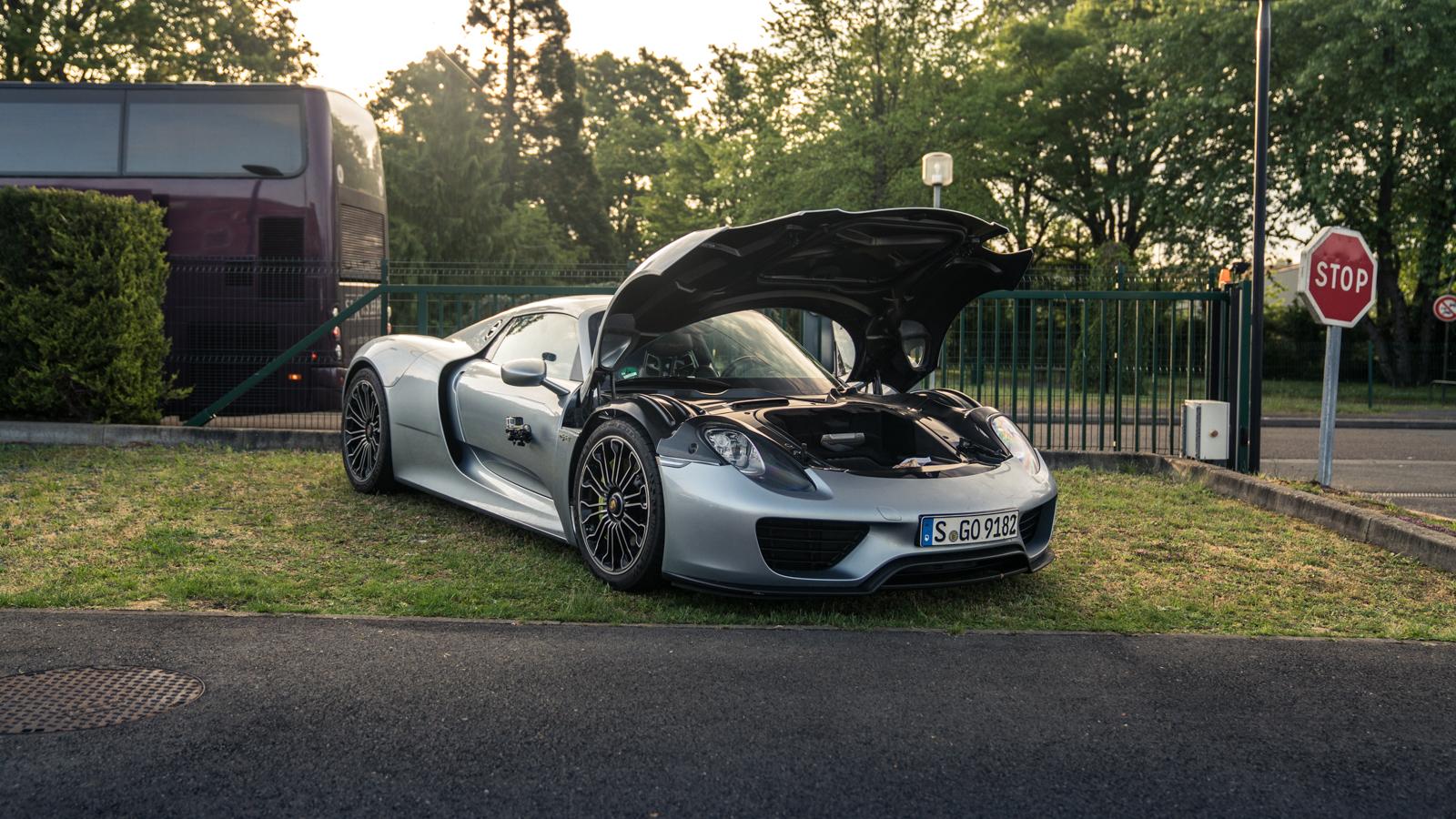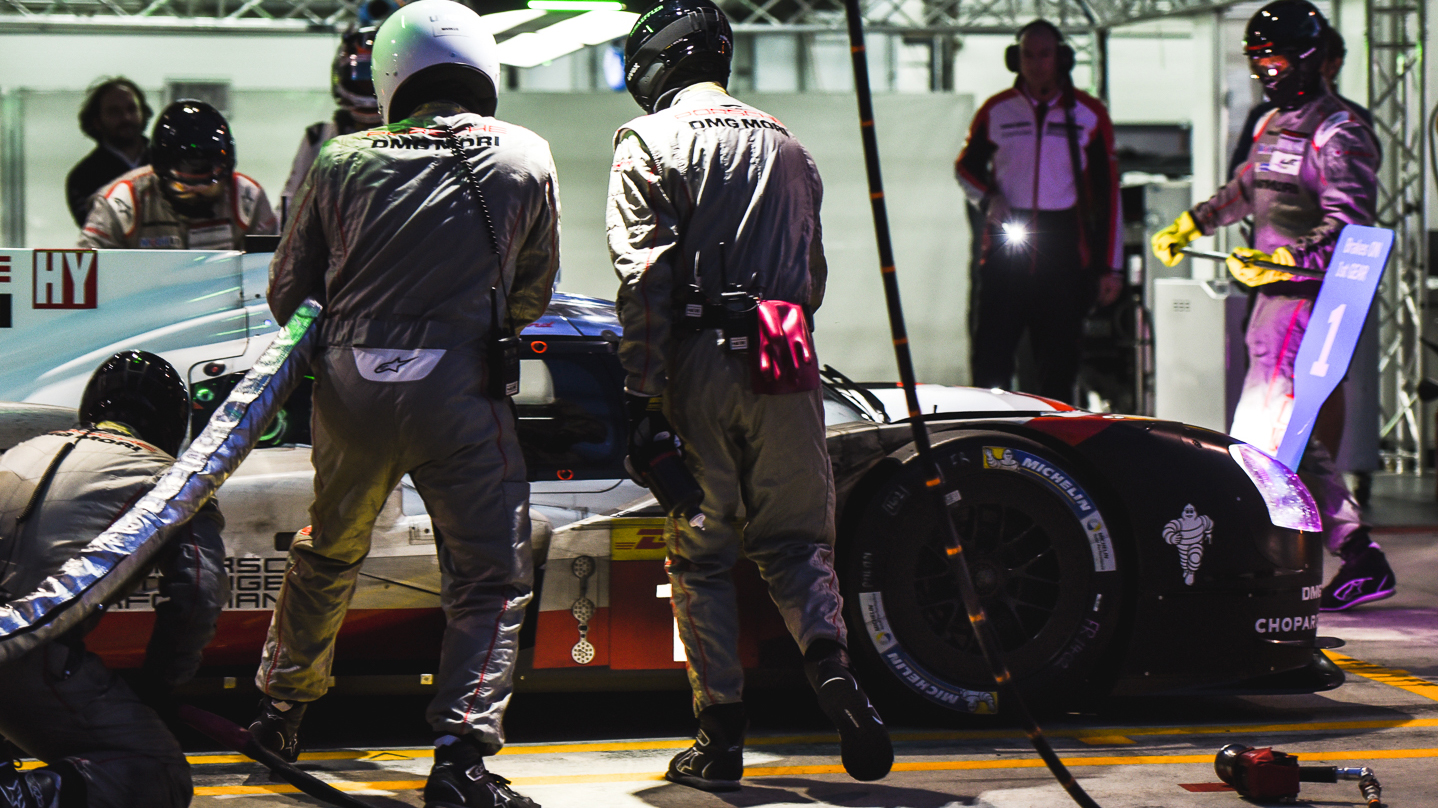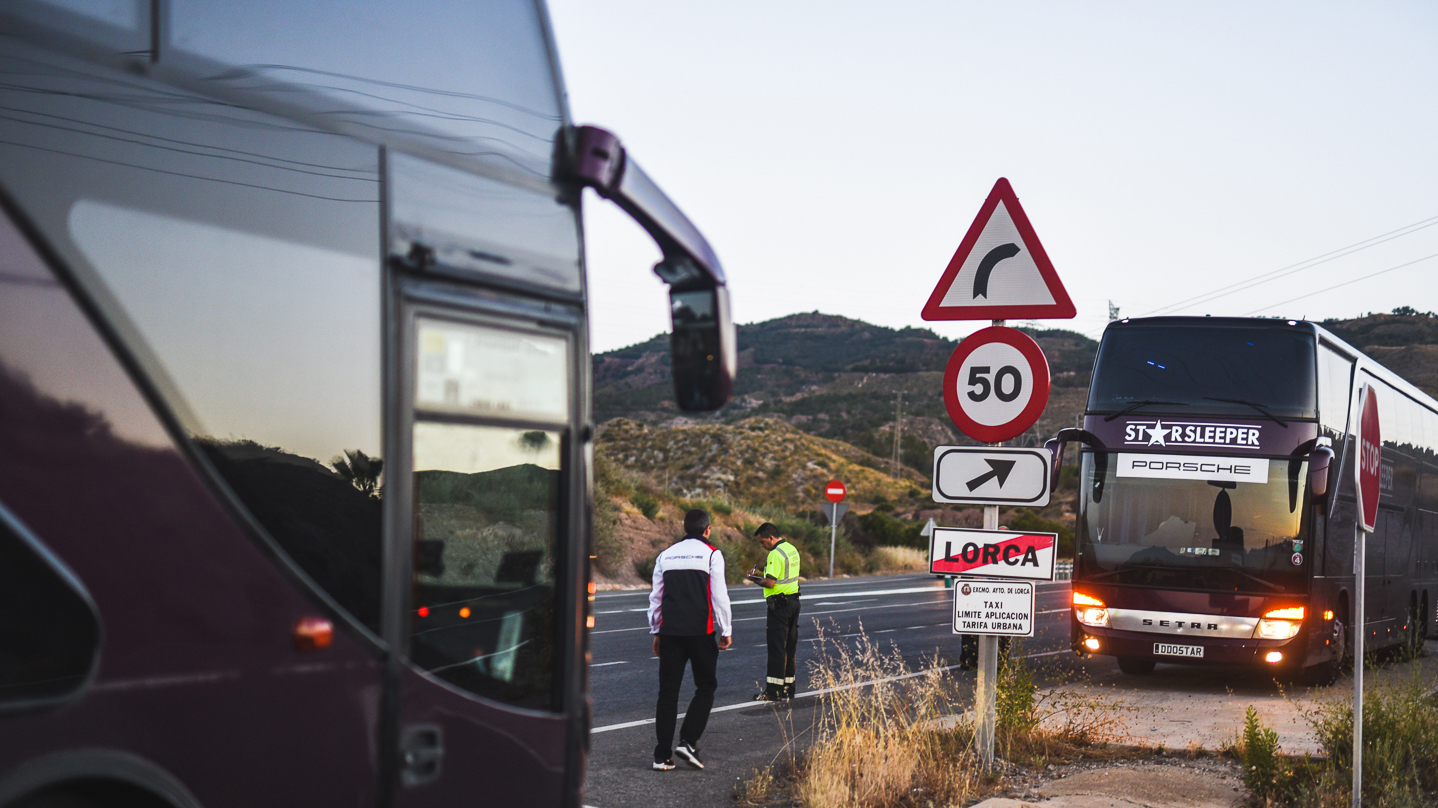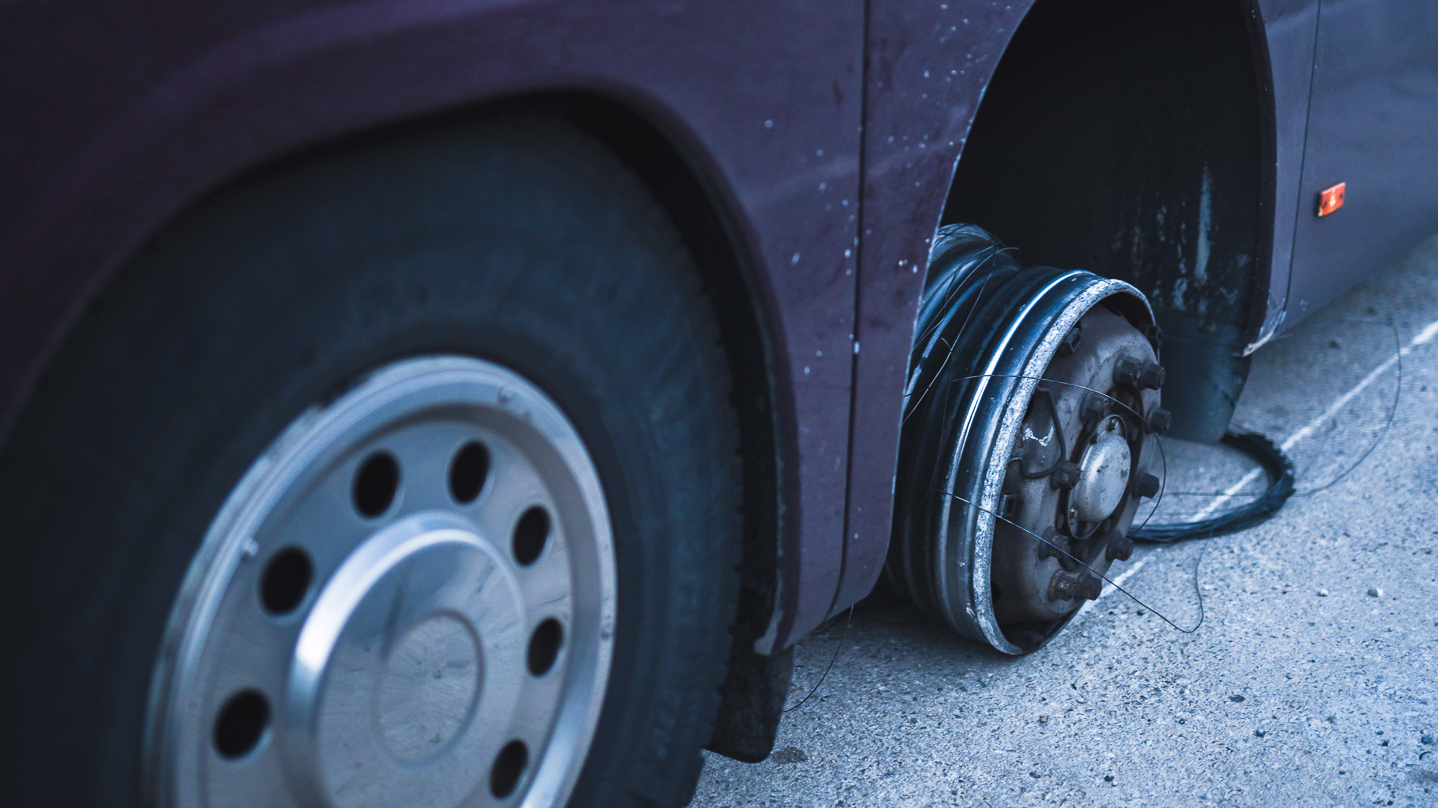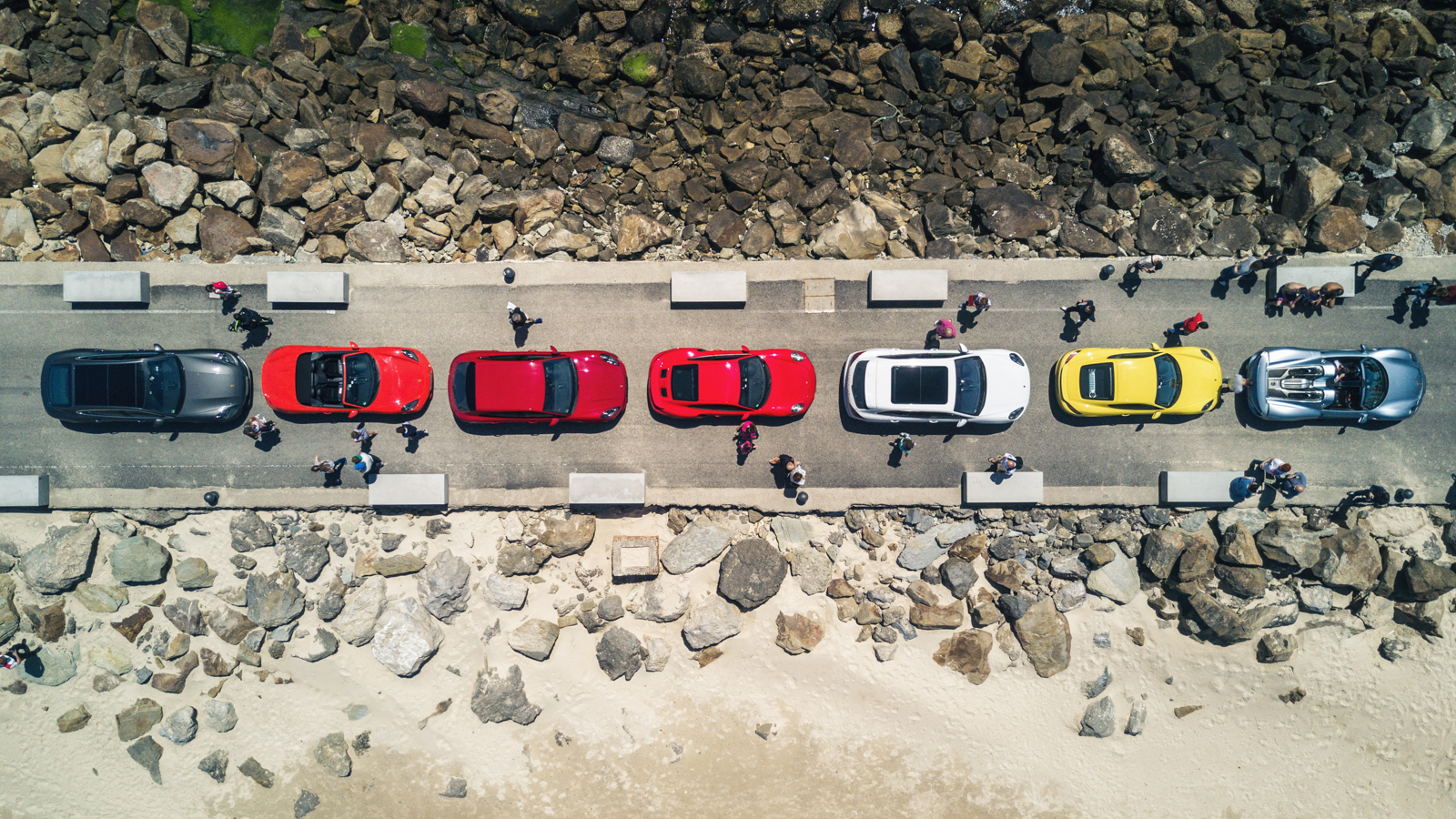
Going the distance: Le Mans race length in Porsche's sports cars
From the Arctic Circle to overlooking Africa in just over three days. We go on a Porsche road trip to remember
Last year, Porsche's race-winning Le Mans car completed 384 laps of Circuit de la Sarthe. Which, with Top Gear’s best back-of-fag-packet calculations, equates to 5,233 kilometres. Or 3,250 miles, if Imperial is your thing. But where would that distance take you if you weren’t going round and round in circles in the middle of France for 24 hours?
Dropping a pin on Google Maps, then stringing it out until it laced its way over Europe’s roads, showed it equalled an eye-widening drive from the Arctic Circle down to the very Southern tip of Europe; touching distance from North Africa. A drive I – possibly foolishly –signed myself up to immediately.
I mean really, just how hard is it for someone like me (an unfit media type who didn’t grow up wearing Nomex pyjamas and working my way up the racing ladder) to experience some of the drudgery and pain of running a car the full Le Mans distance?
Start the clock, and let’s find out.
Words: Rowan Horncastle
Day One
Thursday, 05.30am – Bodø, Norway
The fact that God never seems to turn the lights out in Bodø, Northern Norway, didn’t help the pre-drive early night. In fact, I’ve had barely any sleep. Doesn’t matter. The crisp, chilly Scandinavian air cuts through any tiredness while the beauty of northern Norway’s fjords and snow-capped mountains give you a hit like they’re nature’s double espresso. Then there are the cars on the start line. Yes, plural.
Not content with crossing eight countries in one car, Porsche decided to bring along ALL its cars. One example of each from its range; 718s – in both Boxster S and Cayman S guise – a Macan GTS, Panamera 4S, Cayenne E-Hybrid, Porsche 911 Turbo S and the don – the Porsche 918 Spyder. Which I grab the keys to first. Because hybrid hypercar.
Just before the flag drops, I plumb the finish line ‘Tarifa, Spain’ into the 918’s slab of swipeable touchscreen glass. It takes a few minutes to chew through Europe’s roads before spitting out a drive time of 57 hours. That’s without stopping for the toilet, traffic or any mechanical failure from either car or driver. Gulp. Best get comfortable, then.
Thursday, 06.33am – Fauske, Norway
Damn. The 918 is not a comfortable car. Well, for a lanky git it isn’t. Yes, this might possibly be peak First World Problem. Don’t get me wrong, the packaging is exquisite, technology unprecedented and performance mind-scrambling, but the Weissach Package’s carbon bucket seats force me upward and forward so much I’m hunched over the steering wheel like Quasimodo in a booster seat.
Twiddling the wheel-mounted mode dial to ‘Hybrid’ brings a soundscape unlike any other car. Algorithmically balancing the two power sources – a 563bhp flat-plane crank V8 and 102bhp electric motor – the 918 treats your ears to a myriad of noises. Revs zip from nonexistent while whirring around on electricity, to pure, unadulterated gurgly anger as the race-derived V8 howls to the 9,150rpm limiter. The world also starts to get very blurry very quickly.
Top Gear
Newsletter
Thank you for subscribing to our newsletter. Look out for your regular round-up of news, reviews and offers in your inbox.
Get all the latest news, reviews and exclusives, direct to your inbox.
Luckily, thanks to four-wheel-drive, four-wheel steer, a computer-controlled torque vectoring system and a rear e-diff, even in minus five degrees on summer tyres, the 918 does all it can to keep me going in the direction I point it.
Thursday, 08.04am – Norway-Sweden border
After a few friendly selfies with customs officers, we’re into Sweden and therefore Europe. One country down, seven to go. This is a doddle. However, it’s getting colder and the snowbanks have grown to twice the size they were this morning. I sincerely hope we’re going in the right direction.
Thursday, 09.00am – Artic Circle sign, Sweden
Hurrah! The edge of the Arctic Circle. Which means we must be going in the right direction. However, the gritted roads have cracked the Cayman’s windscreen. And the Cayenne has a screw in its tyre. With no spares until Stockholm – 700 miles away – we could be going up a Le Mans-shaped creek without a paddle sooner than we thought.
Thursday, 12.30pm – Arjeplog, Sweden
The 918’s wonderful weighty steering makes it a joy to thread down Sweden’s fast flowing, tree-lined roads. The ride is brittle, but handles the roads well; even if you can hear every pebble of Norwegian grit rattling around the carbon, soundproof-free arches like you’ve filled a tumble dryer with a fistful of marbles.
We pass Arjeplog, and Porsche’s secret test centre hidden in the woods. Each winter, an army of engineers spend the months up here eating reindeer sandwiches and testing next-gen prototypes until they either break. Or freeze. Or both.
Thursday, 15.00pm – still in the middle of Sweden.
For all its pointless sporty accoutrements and Alcantara steering wheel, thank the Lord this Porsche Macan GTS has ceramic brakes. If it didn’t, there’d be the back half of a reindeer currently parked in its grille. Stubborn blighters, reindeer. They just stand in the middle of the road refusing to move until you politely shoo them off with your front bumper. Santa needs to sort out their manners.
With clear blue skies and ice lakes slowly thawing back to water, the duvet of snow we started with this morning is turning into a dusting with each mile. And less than a day in, our convoy of colourful cars already have five o’clock shadows of filth – making them look thoroughly excellent.
But it feels like there’s really not a lot to do up here in this part of the world – no real feeling of community or local atmos. But there is excellence in the driveways; lots of old American muscle cars, Skidoo jumps and the remains of burnout sessions. I guess either ice fishing or burning rubber are people’s Match.com hobbies up here.
Thursday, 16.30pm – still in the middle of Sweden
Fuel. The all-important go juice that’ll keep this train rolling. The number 2 Porsche 919 (whose odometer we’re chasing) spent a total of 38 minutes and five seconds in the pits for refuelling and tyres over the entirety of last year’s 24-hour race. We spend over that on our first stop. With seven cars to fill, fourteen bladders to empty and supplies to stock up on, it’s not quite the splash-and-dash of a slick race team.
Thursday, 20.23pm – Outside Stockholm, Sweden
Sweden is very big. Well, it definitely feels it. Having thrummed out the 718 Boxster’s lowly four-pot engine (top-down in minus four) for the last few hours, a desperate leg stretch and coffee is needed. So we pull into an unassuming service station.
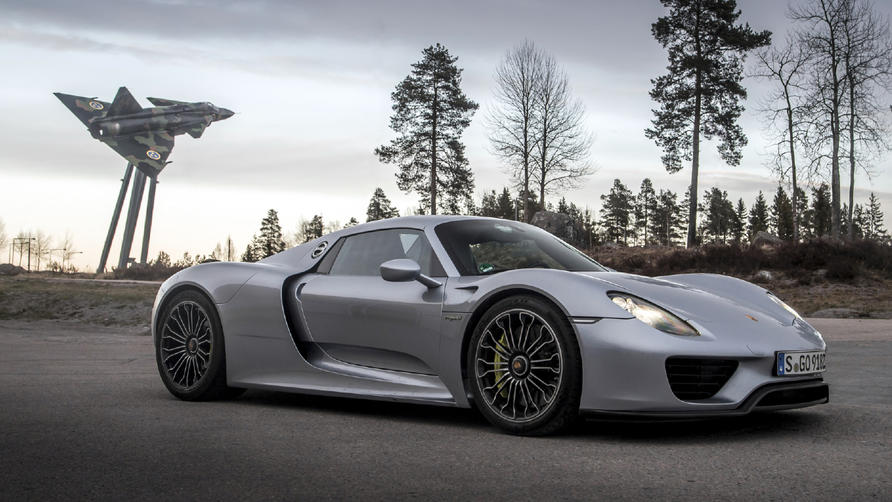
Now, in the UK, Beaconsfield services rates highly for having both a cheeky Nandos and a Weatherspoon’s. But at an unpronounceable service station a few hours outside Stockholm there’s a Saab Viggen on a plinth. A bloody fighter jet. In a service station. Awesome.
The Viggen is the only fighter jet in the world designed around its nation’s motorway network. The radical design requirement was that the aircraft had to have the ability to take-off and land from 500 meters stretches of motorway and could be stored under motorway bridges as bomb protection. Neat, eh?
Thursday, 23.30pm – Eurostop, Arlanda
Exhaustion, disillusion and self-doubt have kicked in. After 15 hours of driving that annoying thing of sleep has got in the way. Otherwise, things could get quite dangerous.
At Le Mans, it’s now compulsory for each car to have three drivers – each must spend at least six hours at the wheel, but must not drive more than four hours within any six, and must not drive for more than 14 hours over the entire distance. Last year, the longest time behind the wheel in the winning car was for Neel Jani with nine hours and 24 minutes. So, I’ve out stinted him.
But in 1952, Frenchman Pierre Levegh drove for 23 hours straight, even though the team had a driver who could have replaced him. As he entered his 23rd hour, leading the race by four laps, his engine failed. Some say that this failure was probably caused by a missed gear change due to driver fatigue, although Levegh never publicly admitted it. I can’t be running those same risks on the public road. However, there is a plan to keep the convoy rolling: tour buses.
In Arlanda, we’re greeted by two proper, bonafide rock tour buses - complete with seedy red strip-lit lighting, blood red and black leather walls, sofas and roofs, suspect chrome piping and a driver with a ponytail, northern accent and tattoos covering a large majority of his body driving up front. I am now officially living out a dream.
The plan each night is to post ourselves into the ‘beds’ (they’re more akin to human shelving units), grab a few hours of kip as the cars chug on, then hop in for another day. Efficiency at its best. With 1,177km knocked out on the first day, we’re making progress. But there’s a long way to go yet.
Day Two
Friday, 06.30am – Malmo, Sweden
Off the bus, into a shower and back into the cars. The unrivalled presence of ratty old Volvos with faces full of fog lights makes me believe we’re still in Sweden. A closer look at a map confirms my thoughts. We’re in Malmo, right on the border of Denmark.
Wanting to ease myself into the day, I grab the keys to the Panamera 4S to chauffeur two Chinese journalists. Pretty fitting, given this is the long-wheel-base ‘Executive’, made purely with the intention of pleasing the Chinese market.
As we cross the the Øresund Bridge – an astonishingly engineered 16km road and rail link between Sweden and Denmark – the Porsche Panamera v2.0 comes into its own. With slimmer LED detailing where blobby lights once sat, angrier 718-style intakes, and a generally less lardy look, it’s now a car you don’t need to carry a brown paper bag in the glovebox to just be sat in.
And you want to be in it. With a physical rev counter framed by twin 7-inch LCD instrument screens, a whopping 12.3-inch main touchscreen, and sensual materials, it’s a smart, luxurious and relaxing cabin. Great for when you’re knocking out monster mileage. Plus, the two Chinese chaps in the back (tapping away on the pull-out tables as their WeChat notifications come pinging in) appear to be happy as Larrys. Or whatever the Chinese name for Larry is.
Friday, 11.03am – Rødby-Puttgarden Ferry
As amazing as the Panamera is, one thing it’s not is amphibious. And to cross Germany you have to negotiate water. So, we hop on the ferry to Germany.
Friday, 15.43pm – Das Autobahn, Germany
The Autobahn is one Germany’s great inventions. As is the 911 Turbo. When you combine the two you’ve got continent crushing at its finest. We’ve spent the last few hours exercising the Turbo’s 'uberholt prestige' by squishing our mileage into submission at a rate of 180-odd miles an hour at points.
Friday, 15.45 pm– Das Autobahn, Germany
The Turbo S is the original gangster of the everyday supercar. A car that offers effortless GT appeal and pulverising performance, all within a purposefully muscular yet wonderfully austere and mature package. Given our objective, this makes it the best car here.
With a 3.8-litre twin-turbo lump slung over the back axle, there’s 572bhp to play with. That makes the latest 911 Turbo S capable of tipping over the double tonne with a blistering top speed of 205mph.
Big, scary numbers those. But on the road, when driven normally, it’s an incredibly docile car. Slot the PDK gearbox down to Drive, keep everything in its factory setting, and you can cruise in comfort for hours. Even with a wide track and tyres, it’s well-mannered on our pitted roads.
But the Turbo S can lull you into travelling at speeds that you just didn’t think relevant, or actually possible. It’s just far too easy to go fast in. Eventually, this would see your driving licence being fed through a police station shredder and you having some long lonely nights in a cold cell away from your children. But in certain parts of Germany, you have complete freedom to go as fast as we like. So, we do.
The Turbo S can lull you into travelling at speeds that you just didn’t think relevant, or actually possible
All you have to do to engage Maximum Autobahn is; wind the mode dial to ‘Sport Plus’, palm the gear stick over to manual, slacken off the dampers and punch it. Mental arithmetic of changing the speed from km/h to mph is quickly made virtually impossible through the sheer rate at which the scenery is passing by the side window. Fatigue (and being a bit thick) also doesn’t help. It’s like trying to think through Marmite.
Friday, 16.22pm – Dortmund, Germany
Wanting to better my top speed and get closer to the 919’s top speed from last year (207mph) I head for the 918. That plan is immediately aborted when it starts absolutely chucking it down and the road becomes a flood. I remember when a colleague asked former Porsche factory driver and certified helmsmith Mark Webber how and when he drives his red Salzburg liveried 918. ‘Never in the wet’ was his response. And he’s a certified F1 World Champ and far handier driver than I, so I’ll take his advice.
Friday, 19:37pm – Roermond, Netherlands
With energy levels depleting, I need a quick pick-me-up. Luckily, we spoke to Porsche’s LMP1 team’s nutritionists before setting off on what to scoff to stay alert. Haribo and giant Cornettos were bad. Nuts, dried fruit and these triple-processed dubious meats were good. In a fit of desperation – and intrigue – I reach for the ‘Hot Amigo’ meat stick. BIG mistake.
I’m told during the 24 Hours of Le Mans, it’s not unusual for a driver to lose 3kg in weight. I have a feeling I can probably match that. And not through sweating.
Friday, 23.05pm – The Tour Bus, Belgium
Day 2 driving complete. The cars have been rolling for 32 hours and we’re 2,726km in and five countries down. Positively knackering.
Day Three
Saturday, 01.54am – Somewhere in Belgium
Trying to sleep on a tour bus while driving on Belgium roads is similar to sleeping through an earthquake. You're pulverised by various seismic waves and oscillations before a giant shelling of pot holes nearly knocks you out of your berth. There have been a few times I was convinced I had woken up halfway through a crash.
Saturday, 08.00am – Le Mans, France
Going to a deserted race circuit is always slightly eerie. But waking up on the Mulsanne Straight when you went to bed in a car park in Belgium is just straight up bizarre. With low, golden light scything through the lengthy tree-lined straight, we hop in the cars for a lap of the iconic circuit.
Approaching Indianapolis, you forget how ballsy the right kink and heftily cambered left corner must be when pitching in an LMP1 car at full chat. Amazingly, someone twists the ACO’s arm enough and we’re granted access to the pitlane and Bugatti circuit (the circuit element that is stiched together with the public road to make the 13.6km Circuit de la Sarthe).
Now, cliché as it is, it’d be wrong not to come to Le Mans, be on the circuit, and not do a Le Mans start, right? So, we line the cars up diagonally on herringbones, cross to the opposite side of the track and make a dash across the track.
The last time the Le Mans start occurred for the race was 1969. For 1970, drivers were strapped into the cars at right angles to the track, and for 1971 the conventional, forward-facing method was used. Nowadays it’s impossible for drivers to leg it across, slither into the cramped LMP1 and safely belt themselves in for it to happen. But we’d be lying if we said we wouldn’t like to see them try.
Saturday, 08.22am – Le Mans, France
A phone call! The Porsche LMP1 team has got wind of our adventure via social media and want us to swing by their last 36-hour endurance test before Le Mans. Problem is, it’s happening tonight at Motorland Aragon – another 1,000km away. Time to put the hammer down.
Saturday, 12.31pm – Somewhere, France
There’s no point in glamming up the staid drive through France. There’s not much to say about the Cayenne E-Hybrid either. It’s the car that’ll go for the longest on a fuel stint here. But with all those extra batteries in the floor, it’s got a harsh ride and the hybrid system is far from harmonious.
Saturday, 15.09pm – France-Spain border
Nothing helps you mentally jot down progress like clearing another country. But as soon as we’re into Spain rozzas divert us off the quick motorway route. To be honest, having spent three days in convoy, a spirited drive across some twistys in the sun is a good way to blow away the cobwebs.
My weapon of choice? The Cayman S. With an on-point chassis, fantastic steering, low and snug driving position, plus performance on the ‘fast-but-not-too-fast’ level, it’s perfect for the job and great fun. But there’s one downfall; that engine.
The road is like a level from RidgeRacer; constantly going from two lanes to one, spearing through tunnels and up and down big undulations. But blatting through a tunnel – something that used to be an instant dopamine with the last car’s sonorous, wailing flat six – is just a bit ‘meh’ in the new car. Don’t get me wrong, the four-cylinder turbo has character of its own, but the budda-budda-budda engine note and faux over fuelled pops and bangs make it feel like a bit of a fraud. It simply doesn’t have the mechanical anger and purity of the naturally aspirated engine. Shame.
Saturday, 16.02pm – Elgorriaga, Spain
Being stationary does not help progress. We’ve been ground to a halt as a load of men in skin-tight lycra have taken over the road for a bicycle race. Do they not know we have somewhere to be?
Saturday, 19.31pm – Zaragoza, Spain
The motorway gantry messages have been right all along. Driving for 49 hours does send you a bit doolally. Well, doolally enough to drive a Boxster S roof down in the thunderstorm, to then become paralysed through laughter from the hilarity of a restaurant simply called ‘Arse’ in the Middle of Nowhere, Spain.
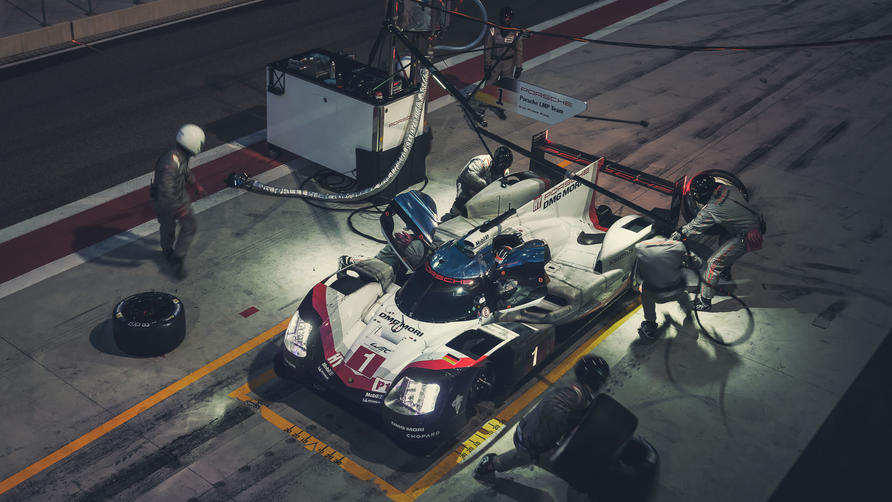
Saturday, 20.22pm – Motorland, Aragon
It feels like a perverse privilege being able to peep into a top secret Le Mans test. When you’re at Le Mans, it’s easy to forget that the cars have been driven to breaking point multiple times in 36-hour tests to make sure nothing goes wrong at the race.
The 919 whizzes around the circuit with a tantalising trail of noises; from the high-pitch electric whines, to big turbo chomphs and harshness of that highly strung V4 engine. Seeing the car in isolation makes you realise how damn quick it is and the unbelievable rate of knots it can go through corners thanks to an intricate and baffling downforce package. It may not be beautiful, but it’s effective.
Five garages in the pit lane house 50 engineers all busily tapping away and deciphering data from the car. There are enough spare parts stacked up in stadium cases to build three new cars from scratch and a full back end including engine and gearbox, brake assembly and suspension sits in the corner already assembled just in case one of the guys has a big one.
The car comes scurrying in under its pit limiter. Brendon Hartley jumps out and British Le Mans winner Nick Tandy hops in for an hour and a half stint. Considering the car has already done 2,400km today, it makes our progress look slow. But with just the final stint to do tomorrow, we’re on the home straight. Now, bed.
Day Four
Saturday, 04.41am – Somewhere, Spain
BIG disaster! Our support tour bus has had a full-on tyre blowout (we're talking nothing but rim left). We put all the refugee staff on our bus and abandon it. We have to finish. But now we’re really behind.
Saturday, 06.20am, The Wild West
The cars stop for a quick photoshoot in an old Western movie set. For no other reason that it looks bloody cool. We hope you agree.
Saturday, 08.27am – Almeria, Spain
Status update from the back of a Panamera as it torpedoes to the southern tip of Spain. The blowout has royally rooted our schedule, so no shower or breakfast as we have to put our foot down.
See, even though we're trying to complete the race distance of Le Mans, we've never actually been racing. But because of the puncture this morning we're a bit up against it for our flights home, and now we kind of are racing. With 62 hours behind the wheel and the odometer reading over 5000km, it’s time to indulge in a shiatsu massage before the final stint to the line.
Saturday, 10.11am – Malaga, Spain
It’d be wrong not to finish this epic trip how we started: in the 918. And it makes more sense now than ever. With timing tight and the sun out, we scalp the two carbon roof panels off, store them in the front and I reacquaint myself with the ‘Race’ setting. With AWD and a race-derived V8 out of the 2005 RS Spyder race car, you can hear the flat-plane crank from four miles away. It’s terrific and sickeningly quick.
Saturday, 12.55pm – Tarifa, Spain
Oops. I nearly crash the 918 from LOLing too hard. With a kilometre to go to the finish, we pass a stranded Toyota Auris Hybrid like it’s a crude set-up. It’s not.
We only came to mimic the distance of last year’s race, but we’ve accidentally mimicked the result too. I tool around town in E-Mode to try and minimise attention. Well, the best you can when you’re in a cavalcade of Porsches behind a police escort going the wrong way through town.
Pulling onto the beach promenade, every tourist drops their buckets and spades to get a glimpse of the cars. Over the bonnet, we reach the water’s edge. We physically can’t drive any further. To my left, Africa. We’ve only gone and bloody done it!
From the Arctic to overlooking Africa in just over three days. 5429km, eight countries, seven cars and only nine minutes over schedule. All the cars wear a smug, dirty grin of expired bugs and aside from a puncture and two cracked screens (consumables) they’ve been faultless troopers.
I, on the other hand, am a broken man. Turns out those LMP1 boys are athletes for what they put themselves through.
Wanting to symbolise the trip in one glass while toasting our triumphant efforts, we order some Norwegian/Spanish boozy fusion thing – sangria with rotting shark fin in, perhaps. Unfortunately, they don't have any rotting shark. So, Aquavit and Spanish fizz it is. Cheers! I’m off for a much-needed shower and a sleep.
Trending this week
- Long Term Review
Life with a 500bhp BMW 550e: do you really need an M5?





